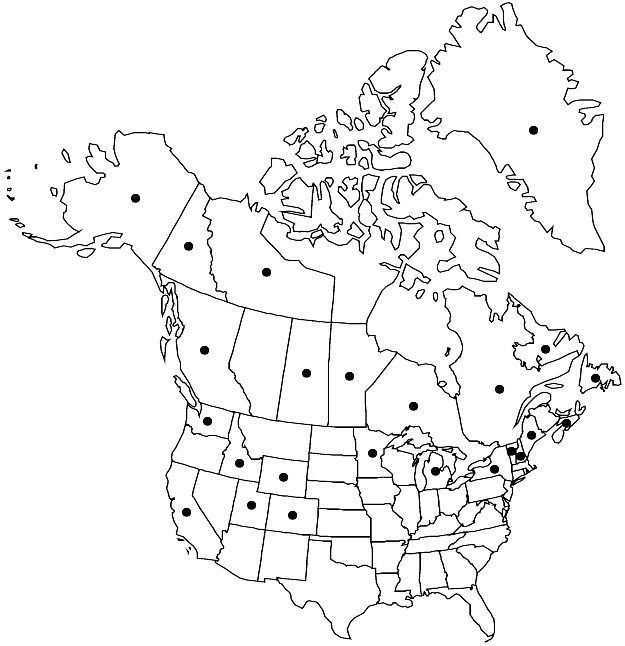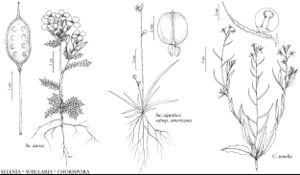Difference between revisions of "Subularia aquatica subsp. americana"
Rhodora 66: 132, plate 1295, fig. 1. 1964.
FNA>Volume Importer |
FNA>Volume Importer |
Revision as of 20:24, 24 September 2019
Stems (0.05–)0.15–1.5(–2.3) dm. Basal leaves erect or ascending, blade subulate, (0.5–)1–7(–10) cm, margins entire; cauline absent. Racemes (1 or) 2–12(–18)-flowered. Fruiting pedicels usually forming 30–50º angle with rachis, slender or slightly stout, 1–7(–10) mm, (sometimes terminal flower on longer pedicel to 18 mm). Flowers chasmogamous or cleistogamous; sepals usually persistent, rarely caducous, (0.5–)0.7–1(–1.3) × 0.2–0.5(–0.7) mm; petals 1.2–1.5 × 0.2–0.5 mm; filaments 0.7–1 mm; anthers 0.1–0.2 mm; gynophore 0.2–0.7(–1) mm. Fruits (0.15–)0.2–0.35(–0.55) cm × 1.2–2(–2.5) mm. Seeds light brown, 0.8–1 × 0.5–0.8 mm. 2n = 30.
Phenology: Flowering Jul–Oct.
Habitat: Muddy pool margins, rocky gravelly bottoms, shallow stream pools, wet sedge meadows, shallow sandy water flats, muddy tidal flats, salt marshes, gravelly lake beaches, stream shorelines, pools and lakes to 1.5 m
Elevation: 0-3200 m
Distribution

Greenland, B.C., Man., Nfld. and Labr., N.W.T., N.S., Ont., Que., Sask., Yukon, Alaska, Calif., Colo., Idaho, Maine, Mich., Minn., N.H., N.Y., Utah, Vt., Wash., Wyo.
Discussion
Subspecies americana appears to be the sole representative of Subularia in North America. It differs from subsp. aquatica, which is restricted to northern Europe and Russia, by having persistent (versus caducous) sepals, fruiting pedicels ascending at 30–50º (versus 50–90º) angles, and broadly ellipsoid to broadly obovoid (versus ellipsoid) fruits. G. A. Mulligan and J. A. Calder (1964) indicated that plants slightly intermediate between the two subspecies grow sporadically in North America, and it is not known whether they represent hybrids.
Selected References
None.
